Configure One-to-One NAT with TMG 2010
In this tutorial we will show you how to configure a one-to-one NAT Rule for internal hosts.
Microsoft Forefront Threat Management Gateway (TMG) 2010 has a lot of advanced features like URL filtering, malicious code protection, Network Inspection System (NIS), HTTPS inspections, and ISP attention. However, below these features there are many other important features as well, one of which needs to be introduced is Enhanced NAT (E-NAT).
One-to-One NAT configuration
E-NAT allows you to forward multiple -to-one or one-to-one IP addresses , such as some existing firewalls (Cisco, Checkpoint, .). However, configuring one-to-one NAT in TMG is not simple. If you are familiar with working with Cisco firewalls and Checkpoint, you will definitely want a NAT rule tab in the TMG management interface and the Networking node . However, the problem is that these are really not here.
In TMG, you create a one-to-one NAT Rule by creating a Network Rule . Suppose we want to forward all traffic coming from an internal host to an IP address assigned to the external network interface of the TMG firewall (not the default IP address for the interface). To do so, open the TMG console and select the Networking button in the navigation menu. Select the Network Rules tab in the central control window, then click Create a Network Rule in the Tasks panel. Name the description for the Rule and select Next .
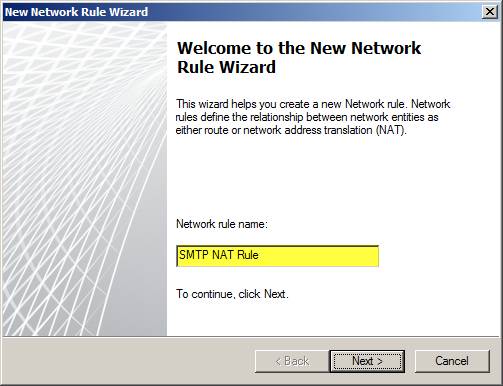
Figure 1
Specify the source of the traffic you want to forward. In this example, we selected a separate server, but you can select networks, a set of networks, a set of computers, a range of addresses, and subnets. This allows us to have high flexibility when establishing NAT relationships in TMG.
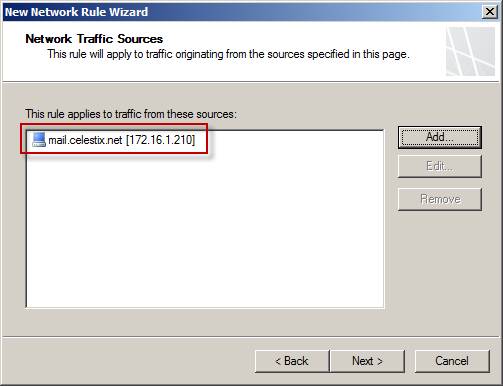
Figure 2
Specify the destination that you want to apply this rule to. In our example, we chose a network outside of External because we want to forward traffic sent from the server using this rule. Here you can choose from a variety of options, which also allow you to have fairly fine-grained control over address forwarding.
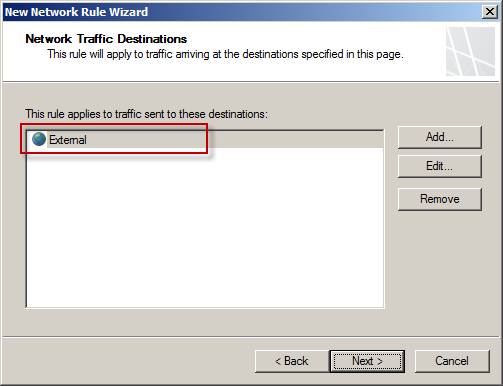
Figure 3
Select the option Network Address Translation (NAT).
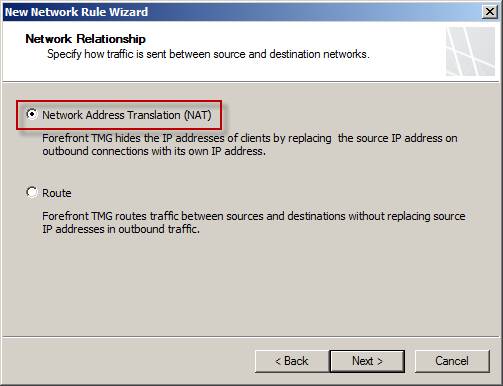
Figure 4
Select the Use the specified IP address option and select the IP address from the available list.
Note:
These IP addresses must be assigned to the network interface first to create the rule, otherwise they will not appear in this list.
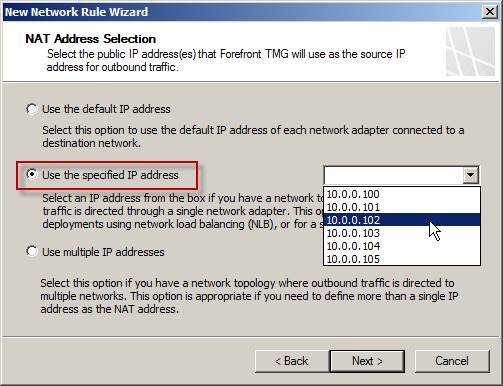
Figure 5
You can also choose the Use multiple IP addresses option , which allows you to select additional IP addresses for the rule (which makes it useful for business arrays when NLB is not enabled).
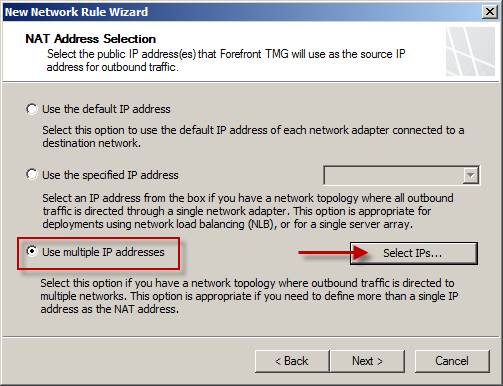
Figure 6
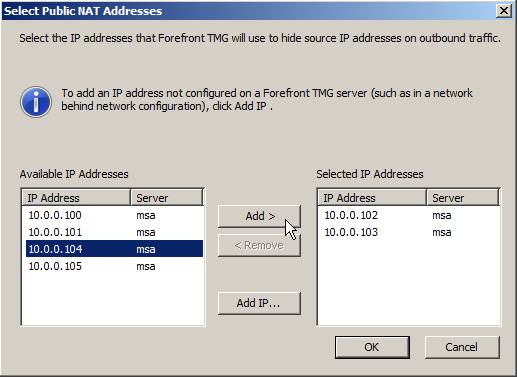
Figure 7
Another important thing you need to know is network rules, like firewall policy rules, they are processed in order. To work properly, more specific rules need to precede other rules. In the example in the article, the specific rule here is defining a NAT relationship between the entire network inside Internal (with the host being one of the members) and the network outside External. After the wizard is complete and before applying the configuration, make sure that this new network rule must appear before the Internet Access rule.
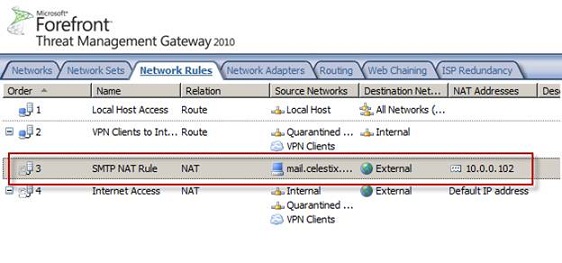
Figure 8
Once configured, the traffic generated from the mail.celestix.net host intended for the network outside the External will match rule number 3, in this rule the network relationship is intended to be NAT, the NAT address is The definition is obviously 10.0.0.2
E-NAT and ISP backup
When the -NAT configuration on the TMG firewall is configured to use a backup ISP (ISP-R), address forwarding may work unexpectedly. When configured, E-NAT rules take precedence and override routing decisions created by ISP-R. Be sure to have a careful plan when implementing both of these techniques.
You should read it
- Install and configure email handling solutions on TMG 2010 Firewall - Part 5
- Instructions to reset Windows Firewall Rules to the initial default state
- Install and configure email handling solutions on TMG 2010 Firewall - Part 4
- 3 ways to turn off the Windows 11 firewall, steps to turn off the firewall on windows 11
- Install and configure the solution to handle email on TMG 2010 Firewall - Part 1: Installation
- Install and configure email handling solutions on TMG 2010 Firewall - Part 2: E-Mail Policy
- What is a firewall? Overview of Firewall
- How to turn on the router's built-in firewall
May be interested
- Configure Smalland: Survive the Wilds on PC
 smalland: survive the wilds is a survival game developed by embu games and released in 2021.
smalland: survive the wilds is a survival game developed by embu games and released in 2021. - Instructions to configure Yahoo mail on Outlook
 no need to configure settings on yahoo mail, all you need to do is configure microsoft outlook to use outlook to send and receive yahoo emails.
no need to configure settings on yahoo mail, all you need to do is configure microsoft outlook to use outlook to send and receive yahoo emails. - How to configure DNS Server on Ubuntu Server 11.04
 dns server is a server with domain name resolution function. in this article, we will detail the steps to install and configure dns server on linux with ubuntu server version 11.04.
dns server is a server with domain name resolution function. in this article, we will detail the steps to install and configure dns server on linux with ubuntu server version 11.04. - How to access and configure BIOS on your computer
 bios helps manage and configure computer hardware, playing an important role in fine-tuning performance. understanding how to access and configure bios helps you adjust cpu, ram, vga parameters easily.
bios helps manage and configure computer hardware, playing an important role in fine-tuning performance. understanding how to access and configure bios helps you adjust cpu, ram, vga parameters easily. - Compare iPhone 11, Pro and Pro Max configurations with the most powerful Android smartphone series available today
 this comparison is only to provide an overview for users in choosing the right smartphone for them.
this comparison is only to provide an overview for users in choosing the right smartphone for them. - Configure wireless connection of Windows Vista from CLI with netsh wlan
 surely one thing that you absolutely can configure wireless networking in windows vista using gui but it's not always simple for most people. how to configure wirelessly from a command line utility
surely one thing that you absolutely can configure wireless networking in windows vista using gui but it's not always simple for most people. how to configure wirelessly from a command line utility - Configure IIS for an FTP Site - Part 1
 in this series, i will show you how to configure iis to work as an ftp server
in this series, i will show you how to configure iis to work as an ftp server - How to set up and configure DDNS on Netgear router
 this guide will help you set up and configure dynamic dns (ddns) on netgear router. using the dynamic dns built into the router means you don't have to keep the computer running all the time on the network to access the remote network.
this guide will help you set up and configure dynamic dns (ddns) on netgear router. using the dynamic dns built into the router means you don't have to keep the computer running all the time on the network to access the remote network. - How to use the Xbox or PS4 game console with Raspberry Pi
 today's article will show you how to make retropie work, before attaching a gaming handle to the raspberry pi.
today's article will show you how to make retropie work, before attaching a gaming handle to the raspberry pi. - Configure Resident Evil 2 Remake on the computer
 here are the hardware names required for resident evil 2 remake on the computer
here are the hardware names required for resident evil 2 remake on the computer










 5 steps to troubleshoot Wi-Fi network problems
5 steps to troubleshoot Wi-Fi network problems Set up remote access with dynamic IP address
Set up remote access with dynamic IP address Optimize performance on Forefront TMG - Part 1
Optimize performance on Forefront TMG - Part 1 Check the 4G speed: Which network is the fastest?
Check the 4G speed: Which network is the fastest? Setting up a VPN server on Router Tomato - Part 1
Setting up a VPN server on Router Tomato - Part 1 Set up a VPN server on Router Tomato - Part 2
Set up a VPN server on Router Tomato - Part 2